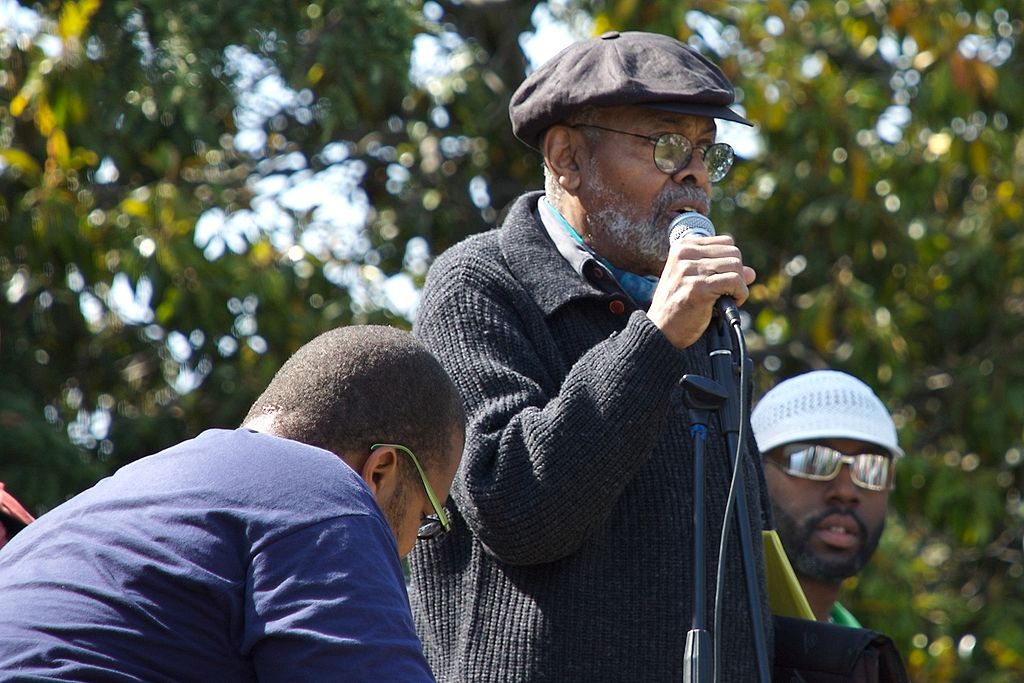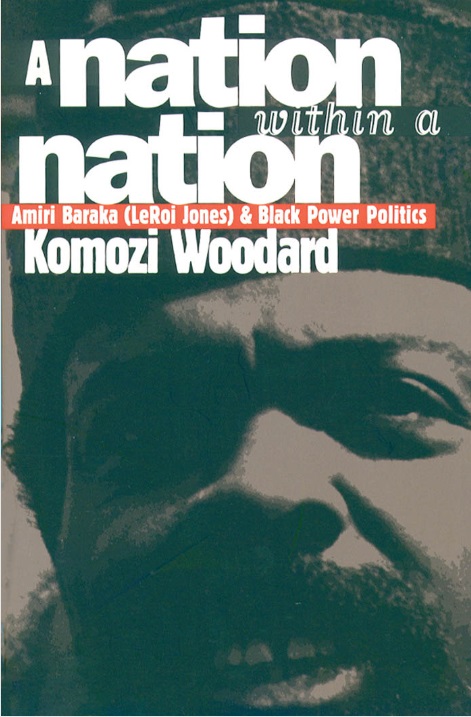Lessons in Revolutionary Black Nationalism
*This post is part of our online roundtable celebrating the 20-year anniversary of the publication of Komozi Woodard’s A Nation Within a Nation

At the 1967 Black Power Conference held in Newark, Amiri Baraka spoke with a bandaged head from the vicious beating he’d received from Newark police in the Black revolt that occurred just days before the conference. A leading Black revolutionary artist and intellectual and a principal architect of the Black Arts Movement, Baraka led arts and culture workshops at the conference. Three years later he emerged as one of the most influential political leaders of the Black Power Movement. Published in 1999, Komozi Woodard’s A Nation Within a Nation: Amiri Baraka and Black Power Politics is a groundbreaking study of Baraka’s journey from poet to political leader and the building of revolutionary Black Nationalist theory and organization in the struggle for Black Liberation. The publication of Nation Within a Nation was exciting because I’d read it when it was still a manuscript. As soon as it was released, I bought a copy, read it, and was even more convinced that this book, this previously untold story from a participant-historian, was an important work on Black Power, Amiri Baraka, the Committee For Unified Newark (CFUN) and the Congress of African People (CAP), grassroots organizing and electoral politics, and Black Nationalism.
Woodard writes with the well-researched detail of a scholar, but the narrative voice of a person with experience conveying Black liberation history to diverse audiences of students, workers, activists, and academics. In this richly constructed telling of one of the most important periods of Black Power, A Nation Within a Nation provides critical areas for study and discussion. They include Black Nationalism as a dynamic and evolving revolutionary force; local organization as the basis of national political organization and movement; the work of developing a revolutionary agenda from the people’s demands; and Amiri Baraka as both actor and symbol of the development and contribution of a Black revolutionary.
Black Nationalism during the Black Power Movement has too often been described as two opposing conceptions: revolutionary nationalism and cultural nationalism. Woodard’s book demonstrates that the determination of a revolutionary Black nationalism is ultimately decided by the work to confront the forces of oppression and transfer power to the people to determine their own lives and destiny.
Malcolm X is the strongest influence on Black Power-era Black Nationalism. Found throughout most Black Power/Black Nationalist organizations are key ideas from Malcolm’s thought and work, especially the necessity to build national consciousness and a broad Black united front to advance an agenda of liberation. The Black Power Movement and organizations were objectively required to go beyond Malcolm, to develop new theory from their practice, to learn from the struggles of the world, and to build the political tools necessary for the reality of Black people in the United States. Many organizations that were placed in the categories revolutionary or cultural nationalist were each attempting to advance that agenda. Unity was often difficult because of political immaturity and the intent of the U.S. state to prevent it through COINTELPRO and other programs.
A Nation Within a Nation demonstrated the dynamic process of theoretical and practical challenges and growth as the work demanded that organizations and activists confront issues of gender, class, religion, and alliances so that new theory and practice could emerge.
The title of the book suggests a conception and demand of Black liberation. It is also an analysis of the persistent context of the U.S. as a historically segregated and oppressive state: two Americas, one Black and one white. In the conception of Black liberation, the idea was to take control of areas where Black people were in the majority as an expression of Black Power. Newark became a major experiment in this form of nation building. In the wake of the passage of the Voting Rights Act of 1965, Black people enthusiastically exercised their newly enforced right to vote. In 1966, Richard Hatcher of Gary, Indiana, and Carl Stokes of Cleveland, Ohio, were the first Black elected mayors of major cities. Over the next decade, Washington DC, Atlanta, Detroit, Newark, and city after city elected Black mayors and often majorities of city government. The success of those elections were coalitions often formed and led by experienced civil rights and union activists, as well as Black church and business leaders.
Newark was unique. Woodard’s book gives an inside look at a Black Nationalist-led movement to take control of a major city. After the 1967 Black Power conference, Amiri and Amina Baraka and others began meeting and organizing to run candidates for mayor and city council. This led to the formation of the Committee for Unified Newark (CFUN), an alliance with the Puerto Rican community, and the eventual successful election of Ken Gibson in 1970. That same year the Black Power Conferences of 1966 through 1969 culminated in the formation of the Congress of African People in Atlanta and, in part because of the success of the Gibson campaign for mayor, Baraka’s emergence as a major leader of the Black Power Movement. The concept of a nation within a nation now had a national Black Nationalist organization with experience in grassroots organizing and electoral politics that could take on the work of building a broad united front around the idea that “It’s Nation Time.”
Key to the advancement of a broad united front of various organizations, ideologies, and personalities was agreement around a set of demands that would create a framework for the Black nation to move forward. Woodard calls that process of building unity the Modern Black Convention Movement to connect it to and distinguish it from the previous convention movements of the late 19th and early 20th century. From 1970-72 local, regional and national gatherings were held around two major projects of the Black Power Movement. Out of the founding conference of the Congress of African People came the call by Amiri Baraka for a national Black political convention that would include newly elected officials, activists, unionists and others to create a national agenda and ongoing structure to advance that agenda. The second, African Liberation Day, was generated from Malcolm X Liberation University and Owusu Sadaukai. Its purpose was to demonstrate solidarity with African people fighting for freedom from colonialism, imperialism, and racism. Both occurred in 1972. The National Black Political Convention in Gary, Indiana, in March where 8,000 activists from the Black Panthers to the SCLC, from Black trade unionists to Black elected officials worked to create and affirm the National Black Agenda. African Liberation Day brought 50,000 Black people to Washington DC in May. These examples of building united fronts on the local level and expanding to the national level are demonstrated throughout the book.
This history, this story within the narrative of Black Power, is told through the formation of political theory and practice of building organizational capacity to create and sustain transformative movement. In this story, Amiri Baraka is a major figure with significant influence over the events that occurred. In writing this book, Komozi Woodard had the difficult but necessary task of documenting Baraka’s role without deifying him or mystifying his work. While it is dangerous and detrimental to teach history as the work of “great” men or women, it is also dangerous and detrimental to negate the impact that significant actors have on historical events. Baraka’s importance and influence on this period of Black Power history is a result of his commitment to building the ideological and organizational capacity of the movement, even if it meant his artistic production and career were negatively impacted. It is also because he understood his principle responsibility was to build for the future by developing young people to think, study, organize, and teach in the fight for liberation. He provided an example of commitment, work, study, discipline, and accomplishment that was expected of the young people who joined the Committee for Unified Newark and the Congress of African People.
For anyone interested in studying or teaching the internal development of a grassroots Black Power organization and understanding the relationship between ideology and practice as a dynamic process, Komozi Woodard’s A Nation Within a Nation: Amiri Baraka and Black Power Politics remains essential reading.
Copyright © AAIHS. May not be reprinted without permission.

I am interested in the unity of Black people…..therefore Black Nationalism is the start in my opinion. Where are others who already have started so as not to recreate the wheel.